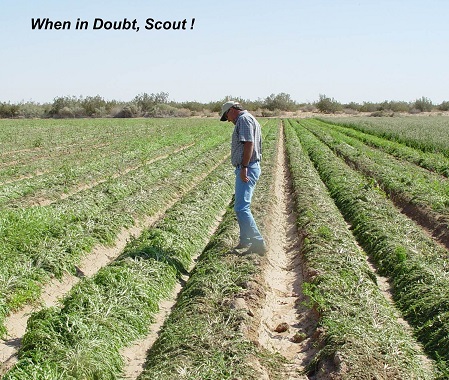
|
|
|
|

|
|||
|
|
|||
|
A notable Hoosier once wrote “Don’t knock the weather. If it didn’t change once in a while, nine out of ten people couldn’t start a conversation”. Thus, I start my update; given the temperatures we’ve experienced the last week or so, one might wonder if summer has arrived early this year. But in fact, today is just the first day of spring, and sadly-or perhaps thankfully- the produce season is quickly winding down. I’ve heard several local growers comment lately that weather played a big role in the market volatility that the produce industry experienced this year. I don’t know about that, but in looking back at the weather records for the past few months, Yuma’s weather this winter was certainly unusual. But don’t we say that every year? I do know this though; insect pressure at the Yuma Agricultural Center was very light winter, lighter than I’ve seen in years. Based on weather data collected from AZMET weather stations throughout Yuma County, average temperatures were warmer in November than in the past several years, but were certainly cooler in January and February compared to last season. This may explain to some degree why aphid and thrips populations have been lower this year compared with what we historically see during this period. Higher winter rainfall in some locations may have also have played a role. Not surprisingly though, thrips numbers are presently building exponentially on our late lettuce trials at YAC, but this is expected given our warm, dry growing conditions and the migration of adults from recently disked lettuce fields. Cabbage lopper, beet armyworm, and diamondback moth numbers are much lower this spring (particularly compared to last spring), and are likely a reflection of the cold nighttime temperatures experienced in January. Whitefly adults are beginning to show up on early melons (at least more so than last year at this time), and this is a bit surprising since we’ve had several freeze events this winter, particularly in the south Yuma Valley and east County. Finally, seed corn maggots have not been a problem to date on either melons or cotton, but this recent warm, dry weather is not considered especially conducive to maggot outbreaks. For a detailed summary of the winter weather data described above, please view the update on Winter Weather Conditions for Yuma County, 2012-2013.
Remember: When in Doubt-Scout.
Click picture to listen to John
To contact John Palumbo go to: jpalumbo@ag.arizona.edu
|
|||
| Back | |||
|
For questions or comments on any of the topics please contact Marco Pena at the Yuma Agricultural Center.
|
|||
|
Home |
Cotton | Veggies |
Forages | Grains
| Citrus |
Crop x Crop Insects | Diseases| Weeds | Pesticides | Economics | News | Weather | Research | Photos | Contacts | General Info. Copyright © 2001 University of Arizona, College of Agriculture and Life Sciences Webmaster: Al Fournier (acis@ag.arizona.edu) |
|||

